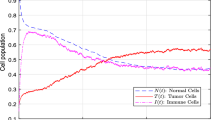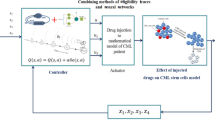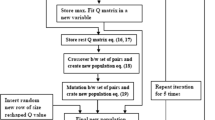Abstract
In this article, the dynamics of cell populations for cancer patients under the treatment of chemotherapy drug administration are reformulated by pseudopartial derivative of input–output data. By utilizing only the tumor cells population as the output and the drug administration as the output data, the model-free adaptive controller is established with two fuzzy-rules emulated networks based on a reinforcement learning scheme with the convergence analysis of internal signals. As a result, the optimal drug administration is derived according to the robustness of individual patients and delaying treatments. The rigorous numerical system is employed to validate the effectiveness of the proposed scheme.














Similar content being viewed by others
Data availability
Enquiries about data availability should be directed to the authors.
References
Babaei N, Salamci MU (2015) Personalized drug administration for cancer treatment using Model Reference Adaptive Control. J Theor Biol 371:24–44
Batmani Y, Khaloozadeh H (2013) Optimal chemotherapy in cancer treatment: state dependent Riccati equation control and extended Kalman filter. Optim Control Appl Methods 34(5):562
Bermudez-Contreras E (2021) Deep reinforcement learning to study spatial navigation, learning and memory in artificial and biological agents. Biol Cybern 115:131–134
Cetin O, Temurtas F (2021) A comparative study on classification of magnetoencephalography signals using probabilistic neural network and multilayer neural network. Soft Comput 25:2267–2275
Chen T, Kirkby NF, Jena R (2012) Optimal dosing of cancer chemotherapy using model predictive control and moving horizon state/parameter estimation. Comput Methods Progr Biomed 108(3):973–983
Chi R, Hui Y, Zhang S, Huang B, Hou Z (2020) Discrete-time extended state observer-based model-free adaptive control via local dynamic linearization. IEEE Trans Ind Electron 67(10):8691–8701
Coelho F, Braga AP, Natowicz R, Rouzier R (2011) Semi-supervised model applied to the prediction of the response to preoperative chemotherapy for breast cancer. Soft Comput 15:1137–1144
Dorosti S, Ghoushchi SJ, Sobhrakhshankhah E, Ahmadi M, Sharifi A (2020) Application of gene expression programming and sensitivity analyses in analyzing effective parameters in gastric cancer tumor size and location. Soft Comput 24:9943–9964
Ekpenyong ME, Etebong PI, Jackson TC, Udofa EM (2020) Modelling drugs interaction in treatment-experienced patients on antiretroviral therapy. Soft Comput 24:17349–17364
Friston K, Samothrakis S, Montague R (2012) Active inference and agency: optimal control without cost functions. Biol Cybern 106:523–541
Hou Z, Chi R, Gao H (2017) An overview of dynamic-linearization-based data-driven control and applications. IEEE Trans Ind Electron 64(5):4076–4090
Jin Y, Ding J (2017) Special issue on “Data-driven evolutionary optimization. Soft Comput 21:5867–5868
Liu J, Wang XS (2019) Numerical optimal control of a size-structured PDE model for metastatic cancer treatment. Math Biosci 314:28–42
Monga B, Wilson D, Matchen T, Moehlis J (2019) Phase reduction and phase-based optimal control for biological systems: a tutorial. Biol Cybern 113:11–46
Mu C, Wang D, He H (2018) Data-driven finite-horizon approximate optimal dontrol for discrete-time nonlinear systems using iterative HDP approach. IEEE Trans Cybern 48(10):2948–2961
Noble SL, Sherer E, Hannemann RE, Ramkrishna D, Vik T, Rundell AE (2010) Using adaptive model predictive control to customize maintenance therapy chemotherapeutic dosing for childhood acute lymphoblastic leukemia. J Theor Biol 264(3):990–1002
Padmanabhan R, Meskin N, Haddad WM (2017) Reinforcement learning-based control of drug dosing for cancer chemotherapy treatment. Math Biosci 293:11–20
Qiu R, Sun Y, Fan Z, Sun M (2020) Robust multi-product inventory optimization under support vector clustering-based data-driven demand uncertainty set. Soft Comput 24:6259–6275
Rihan FA, Velmurugan G (2020) Dynamics of fractional-order delay differential model for tumor-immune system. Chaos Solitons Fractals 132:109592
Robertson-Tessi M, El-Kareh A, Goriely A (2011) A mathematical model of tumor-immune interactions. J Theor Biol 294:56
Shang C, Chen WH, Stroock AD, You F (2020) Robust model predictive control of irrigation systems with active uncertainty learning and data analytics. IEEE Trans Control Syst Technol 28(4):1493–1504
Sharifi M, Moradi H (2019) Nonlinear composite adaptive control of cancer chemotherapy with online identification of uncertain parameters. Biomed Signal Process Control 49:360–4
Sharma PJ, Patel PL, Jothiprakash V (2021) Data-driven modelling framework for streamflow prediction in a physio-climatically heterogeneous river basin. Soft Comput 25:5951–5978
Sweilam NH, AL-Mekhlafi SM, Albalawi AO, Tenreiro-Machado JA (2021) Optimal control of variable-order fractional model for delay cancer treatments. Appl Math Modell 89:1557–1574
Treesatayapun C (2020) Prescribed performance of discrete-time controller based on the dynamic equivalent data model. Appl Math Model 78:366–382
Wieser E, Cheng G (2020) EO-MTRNN: evolutionary optimization of hyperparameters for a neuro-inspired computational model of spatiotemporal learning. Biol Cybern 114:363–387
Yazdjerdi P, Meskin N, Al-Naemi M, Moustafa AE, Kovacs L (2019) Reinforcement learning-based control of tumor growth under anti-angiogenic therapy. Comput Methods Progr Biomed 173:15–26
Zhang M, Gan MG (2019) Data-driven adaptive optimal control for linear systems with structured time-varying uncertainty. IEEE Access 7:9215–9224
Zhang M, Gan MG (2020) Kernel-based Hamilton Jacobi equations for data-driven optimal and H-infinity control. IEEE Access 8:131047–131062
Acknowledgements
The author gratefully acknowledges the contribution of Mexican Research Organization CONACyT Grant # 257253 and CINVESTAV-IPN.
Funding
The authors have not disclosed any funding.
Author information
Authors and Affiliations
Contributions
CT helped in conceptualization, formal analysis, research, MiFREN methodology, validation results, writing, review editing. AJMV contributed to conceptualization, formal analysis, research, controller design, simulations, writing, editing. NS performed validation results, simulations, writing, review editing.
Corresponding author
Ethics declarations
Conflict of interest
The authors declare that they have no conflict of interest.
Ethical approval
This article does not contain any studies with human participants or animals performed by any of the authors.
Informed consent
Written informed consent for publication was obtained from all participants.
Additional information
Publisher's Note
Springer Nature remains neutral with regard to jurisdictional claims in published maps and institutional affiliations.
Rights and permissions
Springer Nature or its licensor (e.g. a society or other partner) holds exclusive rights to this article under a publishing agreement with the author(s) or other rightsholder(s); author self-archiving of the accepted manuscript version of this article is solely governed by the terms of such publishing agreement and applicable law.
About this article
Cite this article
Treesatayapun, C., Muñoz-Vázquez, A.J. & Suyaroj, N. Reinforcement learning optimal control with semi-continuous reward function and fuzzy-rules networks for drug administration of cancer treatment. Soft Comput 27, 17347–17356 (2023). https://doi.org/10.1007/s00500-023-08068-1
Accepted:
Published:
Issue Date:
DOI: https://doi.org/10.1007/s00500-023-08068-1




